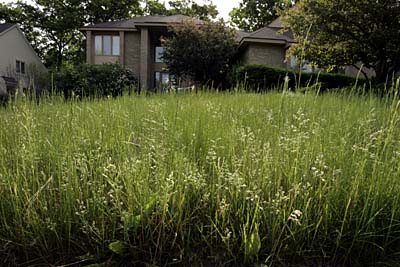Nuisance Property Television--More "cutting-edge" tv from the land of Desperate Housewives
DC Government broadcasts a variety of hearings, including those of City Council, on cable television. If you ever testify before Council, people will mention that they "saw you on tv." To see the DC Government Cable Television Schedule, click here.
This article from the Detroit News, "Suburbs weed out untidy lawns: Metro officials target unsightly yards as fed-up neighbors complain about unkempt property" discusses how some suburban Detroit communities are addressing nuisance properties.
 Todd McInturf / The Detroit News. A notice hangs on the door notifying the owner of this West Bloomfield Township house to cut the grass. If it isn't taken care of, the township will cut the grass Tuesday at the owner's expense.
Todd McInturf / The Detroit News. A notice hangs on the door notifying the owner of this West Bloomfield Township house to cut the grass. If it isn't taken care of, the township will cut the grass Tuesday at the owner's expense.Obviously, we have the same problems in the city, and "Clean it and Lien it" programs don't seem to do that much when addressing recalcitrant property owners. For example, at a meeting last week, I learned that the city spends $2.5 million+/year cleaning up vacant properties.
From the article: "Left unaddressed, bad lawns and other eyesores irk neighbors and carry a price, experts say. "It has a huge impact on the property next door," said Patti Mullen, a Remerica Hometown One Realtor in Plymouth. "It deters more buyers, which means fewer offers and less money."
Bob Townsend can relate. His 1,300-square-foot home is within walking distance of downtown Northville, but he pulled it off the market earlier this year when few lookers came through. Next door is a vacant property with uncut grass and a dilapidated look."
There is something quite interesting in this article though, that bears consideration for DC:
Televised hearings and posted, placarded notices
Communities across Metro Detroit have different tolerance levels for lawn length, vehicle storage and home maintenance... City officials also have different ways of getting residents to clean up their act.
In Sterling Heights, five ordinance enforcement officers patrol the neighborhoods. The complaints ultimately land before the Board of Ordinance Appeals, a group of five residents appointed by the City Council to settle disputes. Offending homeowners are summoned to the City Council chambers. A poster-sized sign is placed in the front yard alerting neighbors to the hearing so they can attend and comment if they choose.
The hearings are shown on the city's cable television channel. At them, code enforcement officers use laptop computers to display digital photos of the offending property on a large screen in the council chambers. A cursor darts around the screen pointing to the most egregious violations. "A picture is worth a thousand words," said building official Michael Bartholomew."
_________
Maybe we need to think about expanding our thinking about hearings and broadcasting. Perhaps tactics such as these can help us better address these problems in DC.
From the Sterling Heights TV website:
"Watch your municipal representatives at work LIVE! Broadcast meetings include City Council, Telecommunications Commission, Planning Commission, Board of Zoning Appeals and the Ordinance Board of Appeals. "
 Learning from the suburbs that sometimes City TV might not go far enough.
Learning from the suburbs that sometimes City TV might not go far enough.



0 Comments:
Post a Comment
<< Home